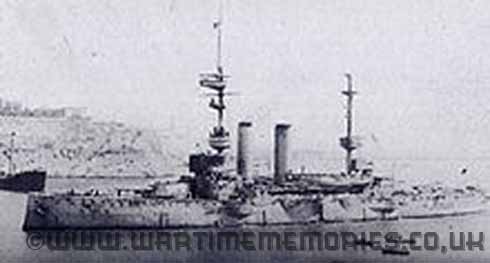1st July 1914 HMS Prince of Wales 
HMS Prince of Wales - Malta 1915
HMS Prince of Wales, member of Formidable Class - Queen subclass of pre-dreadnought Battleships.
The Royal Navy's Formidable-class battleships were an eight-ship class of pre-dreadnoughts designed by Sir William White and built in the late 1890s. The class is often further divided into a separate London class, and the London class sometimes is divided further into a separate Queen class.
Queen subclass
The last two London class ships to be built, Prince of Wales and Queen, were identical to the other Londons except that they had open 12-pounder gun batteries mounted in the open on the upper deck amidships and had a lower displacement. Queen and Prince of Wales were laid down after the Duncan-class battleships that succeeded the Formidables and Londons, and were completed after the Duncans as well. They are generally considered part of the Formidable or London class, but the difference in the mounting of their 12-pounder guns, their lower displacement, and their later construction than the Duncans lead some authors to view them as constituting a Queen class separate from the Formidable and London classes.
The last of the ships to commission, Prince of Wales, was the last battleship for which Director of Naval Construction Sir William Henry White had sole design responsibility. She also was the last of the 29 battleships of the Majestic, Canopus, Formidable, London, Duncan, and Queen classes, commissioned between 1895 and 1904, which had all been based on the single, standard Majestic design and reached their final development in Queen and Prince of Wales.
Like all pre-dreadnoughts, the Formidables, Londons, and Queens were outclassed by the dreadnought battleships that began to appear in 1906. However, they continued in front-line duties through the early part of World War I.
HMS Prince of Wales was laid down at Chatham Dockyard on 20 March 1901, the first keel plate laid down by Lady Wharton, wife of Rear-Admiral Sir William Wharton, Hydrographer to the Admiralty. She was launched by Mary, Princess of Wales, on 25 March 1902 and completed in March 1904.
Upon completion in March 1904, HMS Prince of Wales immediately went into the Fleet Reserve at Chatham Dockyard. She commissioned there on 18 May 1904 for service with the Mediterranean Fleet. While in the Mediterranean, she collided with the merchant steamer SS Enidiven on 29 July 1905, suffering no serious damage. In April 1906 she had a fatal accident when she suffered a machinery explosion during high-speed trials; three men were killed and four injured. On 28 May 1906, she ended the first Mediterranean tour by paying off at Portsmouth Dockyard and went into the commissioned reserve for a refit.
On 8 September 1906, Prince of Wales again commissioned for Mediterranean Fleet service. She became Second Flagship, Vice Admiral, in August 1907, and underwent a refit at Malta in 1908.
Prince of Wales transferred to the Atlantic Fleet as Flagship, Vice Admiral, in February 1909,[9] and underwent a refit at Gibraltar in 1911.
Prince of Wales transferred to the Home Fleet on 13 May 1912, becoming Flagship, Vice Admiral, 3rd Battle Squadron, First Fleet, then later in 1912 Flagship, Rear Admiral, Second Fleet, at Portsmouth, and part of the 5th Battle Squadron. On 2 June 1913, she was rammed by submarine HMS C32 while participating in exercises, but suffered no damage.
World War I
When World War I broke out in August 1914, Prince of Wales was Flagship, 5th Battle Squadron. The squadron was assigned to the Channel Fleet and based at Portland, from which it patrolled the English Channel. Prince of Wales and other ships of the squadron covered the movement of the Portsmouth Marine Battalion to Ostend, Belgium, on 25 August 1914. On 14 November 1914 the squadron transferred to Sheerness to guard against a possible German invasion of the United Kingdom, but it transferred back to Portland on 30 December 1914.
Dardanelles campaign
On 19 March 1915, Prince of Wales was ordered to the Dardanelles to participate in the Dardanelles Campaign. She departed Portland on 20 March 1915 and joined the British Dardanelles Squadron on 29 March 1915. She supported the landings of the 3rd Brigade, Australian Army, at Gapa Tepe and Anzac Cove on 25 April 1915. During this time her second-in-command was Commander Kenneth Dewar, later a controversial figure in the Royal Navy.
Adriatic operations
On 22 May 1915, Prince of Wales, along with battleships HMS Implacable, HMS London, and HMS Queen, was transferred to the Adriatic Sea to form the 2nd Detached Squadron, organized to reinforce the Italian Navy against the Austro-Hungarian Navy after Italy declared war on Austria-Hungary. Prince of Wales arrived at her new base, Taranto, Italy, on 27 May 1915.
Prince of Wales became flagship of the squadron in March 1916. She ended her flagship duties in June 1916, when she went to Gibraltar for a refit. She later returned to the Adriatic.
Decommissioning and subsidiary duties
In February 1917, Prince of Wales was ordered to return to the United Kingdom. On her voyage home, she called at Gibraltar from 28 February 1917 to 10 March 1917 and arrived at Devonport Dockyard later in March. She was placed in reserve on arrival, and was used as an accommodation ship.
Disposal
Prince of Wales was placed on the disposal list on 10 November 1919, and was sold for scrapping to T. W. Ward and Company on 12 April 1920. She arrived at Milford Haven for scrapping in June 1920.
John Doran
If you can provide any additional information, please add it here.





